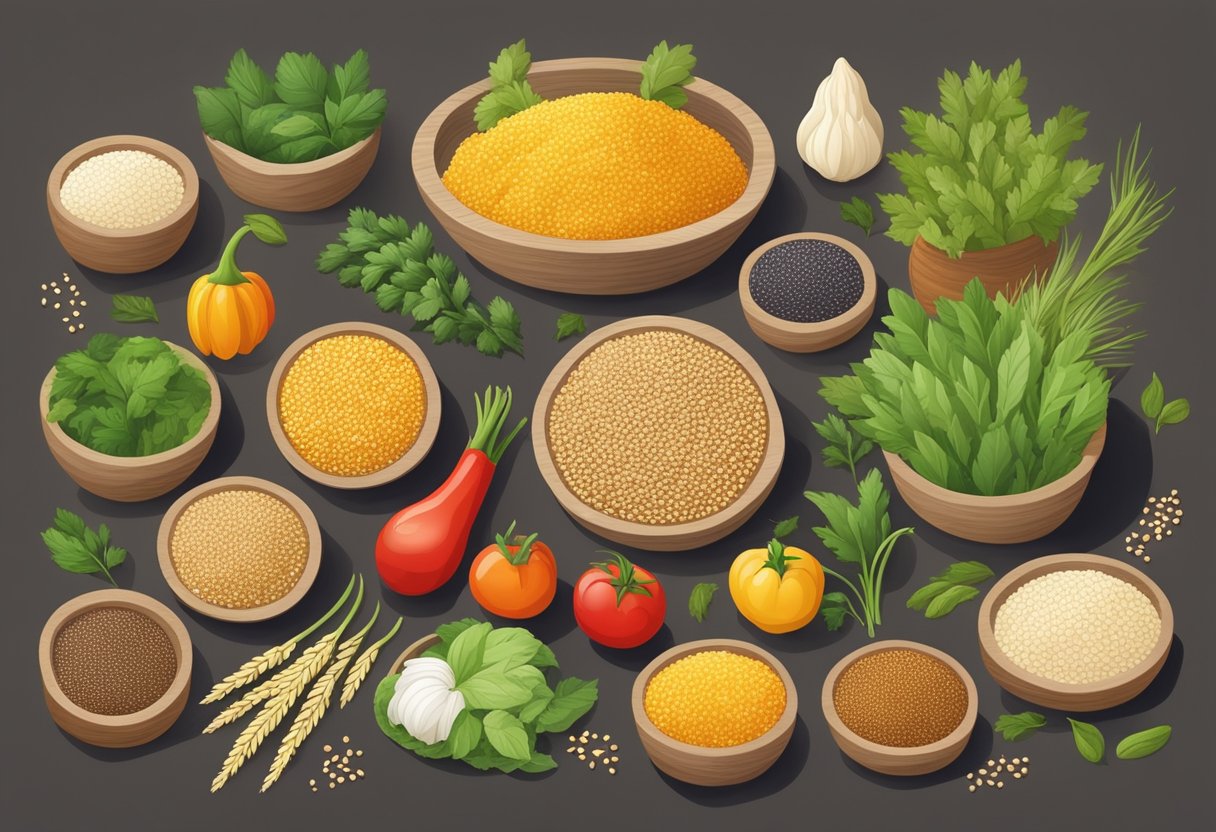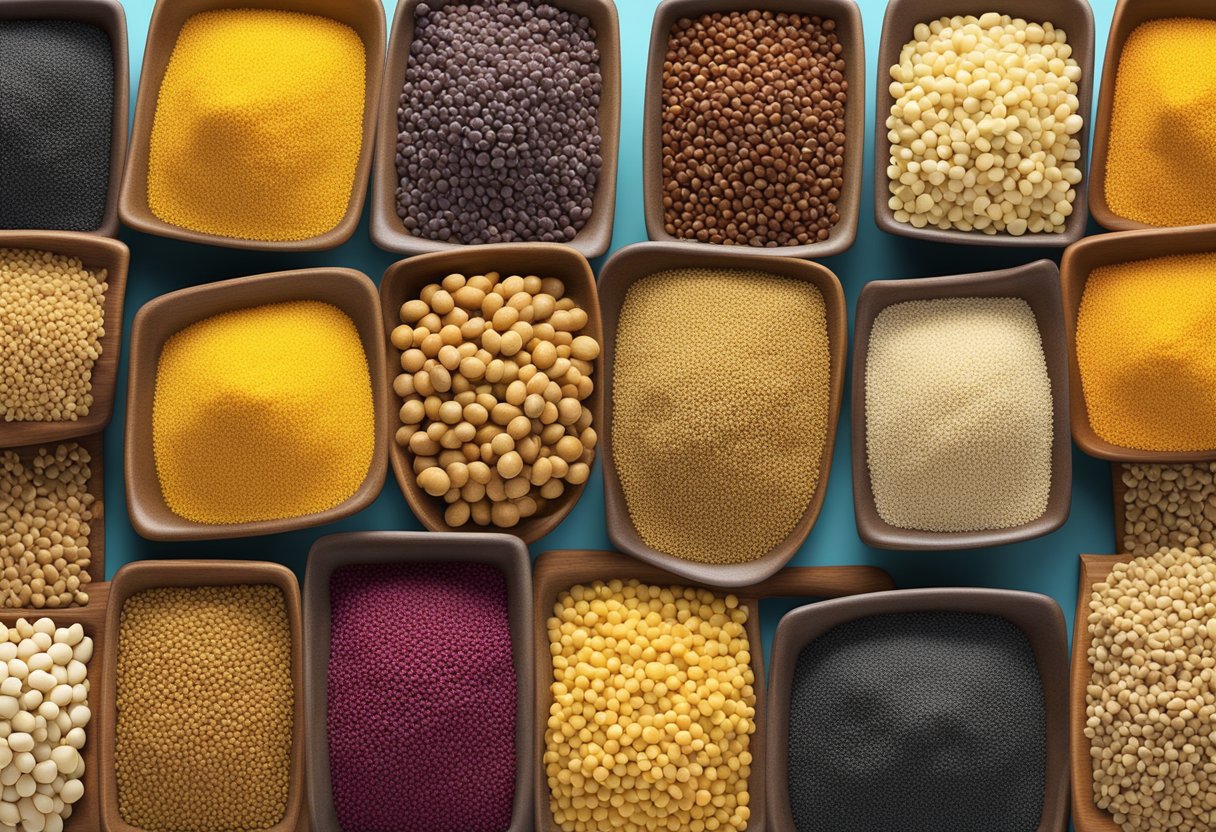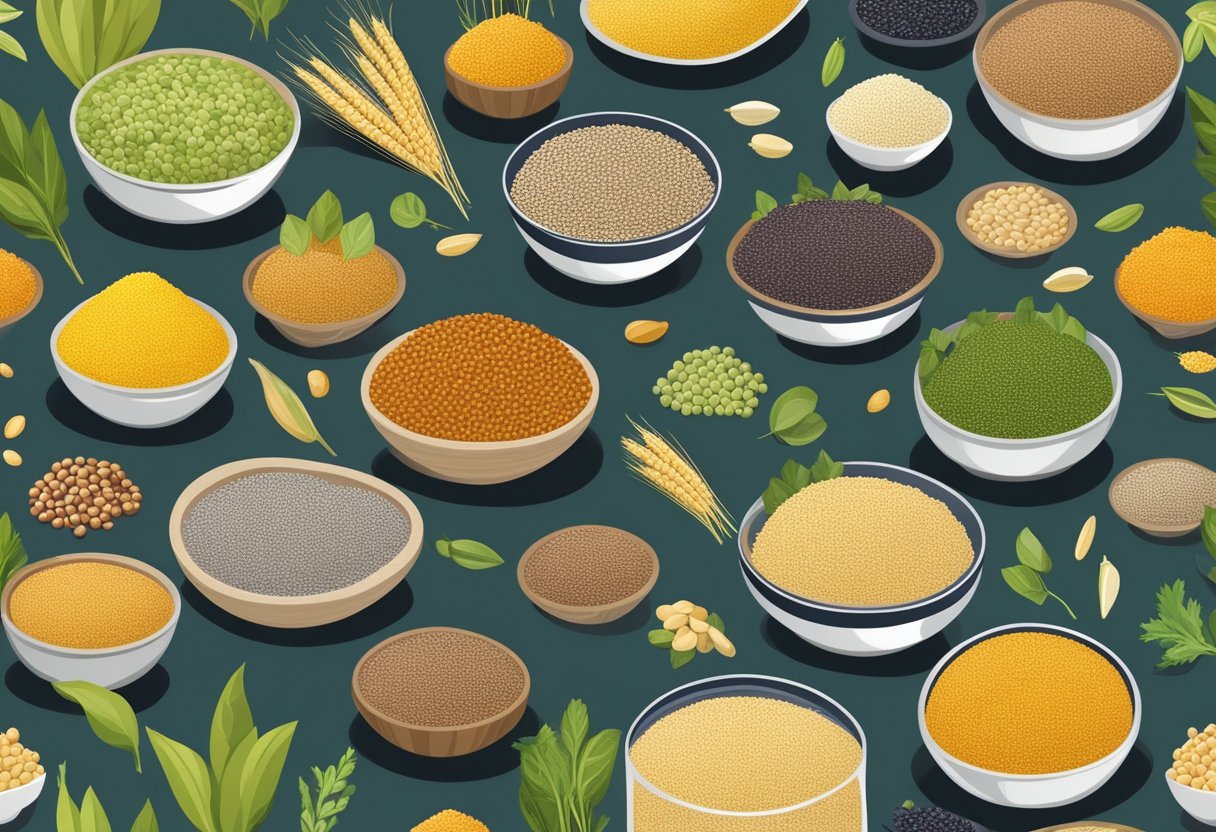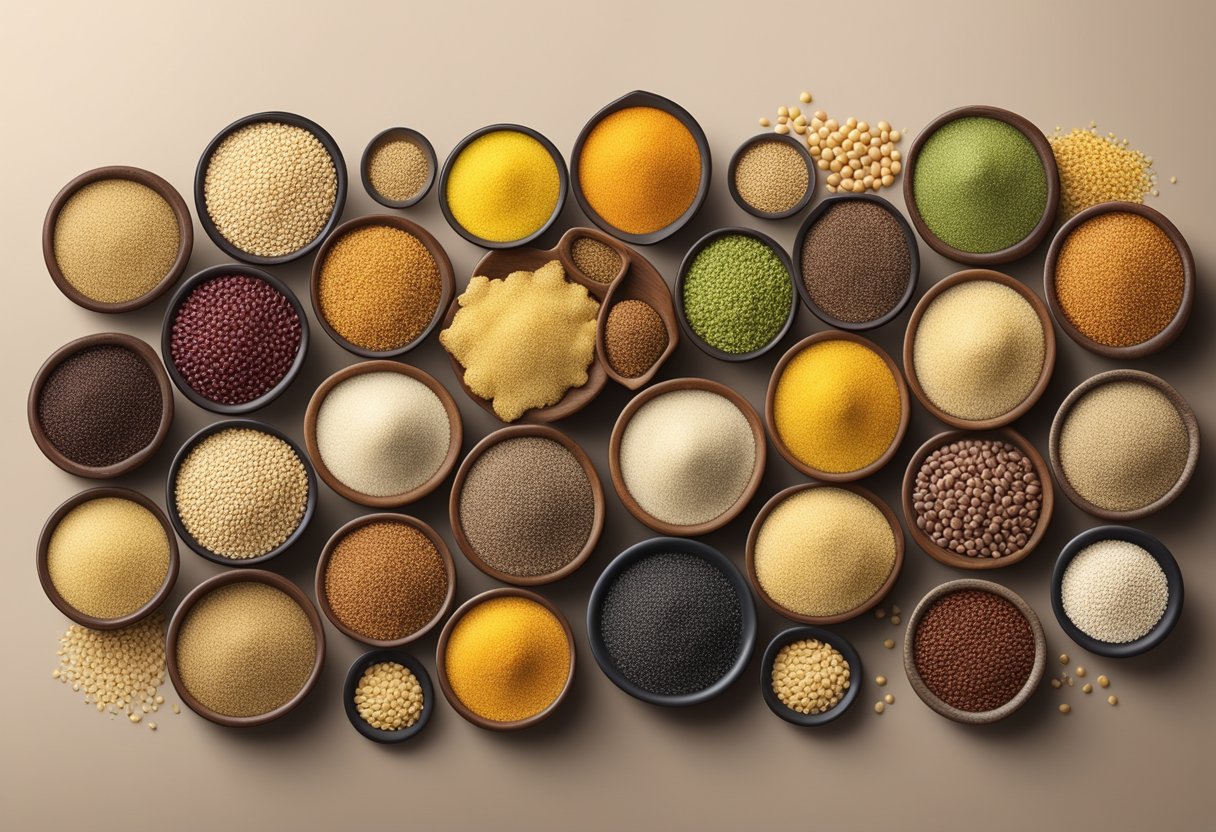As the popularity of gluten-free diets continues to rise, so does the demand for versatile, gluten-free grains that can be used in a variety of dishes. Gluten-free grains like quinoa and millet have become culinary staples for those looking to maintain a healthy eating lifestyle without sacrificing flavor or texture. Quinoa, often lauded for its high protein content and complete amino acid profile, serves as an excellent base for salads and a nutritious replacement for traditional grains. Millet, with its mild, nutty flavor, is another gluten-free option that functions wonderfully in side dishes, providing essential nutrients without gluten’s adverse effects.

Venturing beyond these two grains, there are several other gluten-free alternatives that fit seamlessly into a Mediterranean diet, known for its emphasis on whole foods and plant-based ingredients. These grains, including buckwheat, amaranth, and teff, offer a wealth of health benefits and culinary diversity. They can be cooked and added to salads, served as a side, or creatively repurposed into a myriad of recipes. The key to a flavorful and satisfying gluten-free meal often lies in the proper cooking and seasoning of these grains, ensuring they complement the fresh vegetables, healthy fats, and lean proteins typical of Mediterranean cuisine.
Key Takeaways
- Gluten-free grains like quinoa and millet are healthy, flexible options for salads and side dishes.
- A variety of gluten-free grains can enhance a Mediterranean diet with minimal effort required for preparation.
- Proper cooking techniques and seasoning are crucial in maximizing the flavor and nutritional benefits of gluten-free grains.
Table of Contents
Understanding Gluten-Free Grains
When one adopts a gluten-free Mediterranean diet, it is important to understand which grains can enhance meals without causing gluten sensitivity issues. Gluten-free grains are not only versatile in recipes but also offer a wealth of health benefits.
What Are Gluten-Free Grains?
Gluten-free grains are seeds or cereals that do not contain gluten, a group of proteins found in wheat, barley, and rye. These grains are safe for individuals with celiac disease or gluten sensitivity. Corn, oats (if they are certified gluten-free to avoid cross-contamination), quinoa, buckwheat, amaranth, millet, teff, sorghum, and wild rice are all naturally gluten-free and suitable for a Mediterranean diet.
Health Benefits of Gluten-Free Grains
Gluten-free grains are not just alternatives to wheat; they pack a nutritional punch. Rich in fiber and protein, these grains contribute to a feeling of fullness and support digestive health. They are sources of essential minerals such as iron, calcium, and magnesium, which are crucial for bone health and metabolism. Additionally, gluten-free grains often contain B vitamins, antioxidants, and other important nutrients like manganese, folate, copper, potassium, and vitamin B6, promoting overall wellness and chronic disease prevention.
Common Gluten-Free Grains and Their Nutritional Profiles
Below is a table outlining the nutritional benefits of popular gluten-free grains used in salads and side dishes:
| Grain | Protein (per 100g) | Fiber (per 100g) | Key Nutrients |
|---|---|---|---|
| Quinoa | 14g | 7g | Complete amino acid profile, magnesium, phosphorus |
| Millet | 11g | 12g | Magnesium, zinc, B vitamins |
| Buckwheat | 13g | 10g | High in antioxidants, manganese |
| Teff | 13g | 8g | Calcium, iron, amino acids |
| Amaranth | 14g | 7g | Iron, magnesium, phosphorus |
Each grain presents unique flavor profiles and culinary possibilities that complement the rich tapestry of a gluten-free Mediterranean diet. These grains can be the foundation for nutrient-dense salads and fulfilling side dishes that adhere to a gluten-conscious lifestyle.
Quinoa: The Complete Protein Seed

Quinoa, often integrated into a gluten-free Mediterranean diet, stands out as a versatile seed that is prized for its high protein content and nutritional density.
Quinoa’s Nutritional Value
Quinoa is not only a complete protein, containing all nine essential amino acids, but it is also rich in fiber and iron. This makes quinoa an excellent choice for lunch or dinner. For example, a serving of quinoa provides significant amounts of nutrients needed for daily metabolism and health.
Cooking and Rinsing Quinoa
To prepare quinoa, it is important to rinse the seeds thoroughly to remove saponins, which can impart a bitter taste. Cooking it is similar to rice—using two parts water to one part quinoa and simmering until it becomes translucent and tender.
Incorporating Quinoa Into Salads and Side Dishes
Quinoa’s fluffy texture and slightly nutty flavor make it an ideal base for a variety of quinoa salad recipes. It can be mixed with vegetables, nuts, and dressings for a nutritious gluten-free meal, embodying the essence of Mediterranean cuisine.
Millet: A Versatile Grain for Any Meal

Millet stands out in the culinary world for its nutritional richness and gluten-free nature, making it an ideal choice for diverse cuisines, including those following a Mediterranean diet. Its adaptability in various dishes, from porridges to baking, is complemented by its earthy taste.
Millet in the Kitchen
Millet is highly versatile in cooking. It can be transformed into a creamy porridge, combined into salads for a nutritious punch, or even used in baking to create gluten-free breads and cakes. Its ability to absorb flavors makes it an excellent accompaniment in a Mediterranean diet, which emphasizes the use of fresh, aromatic herbs and spices.
- Cooking methods:
- Boiling: Creates a fluffy texture, similar to couscous.
- Toasting: Enhances the earthy taste, providing a nuttier flavor.
- Steaming: Yields a stickier consistency, ideal for Mediterranean side dishes.
The grain’s popularity spans across various continents, including parts of Africa, where it’s a staple food, and India, where it’s frequently used in traditional dishes.
Health Benefits of Millet
Millet is not only gluten-free, making it suitable for those with celiac disease or gluten intolerance, but it’s also nutritious. It’s packed with vitamins, minerals, and fiber, contributing to a well-rounded Mediterranean diet.
- Nutritional profile highlights:
- High in magnesium, which supports heart health.
- Rich in B vitamins, particularly niacin, B6, and folic acid.
- Contains antioxidants, which combat oxidative stress.
As a grain that supports various dietary needs while promoting health, millet has earned its place as a favored option in gluten-free grains, both for its versatility in the kitchen and its robust health benefits.
Beyond Basics: Other Gluten-Free Grains
As one explores gluten-free options beyond quinoa and millet, a variety of nutritious grains come to the forefront, each bringing unique flavors and health benefits suitable for Mediterranean-inspired salads and side dishes.

Including Lesser-Known Grains
One should not overlook lesser-known grains like teff and amaranth. Teff, an ancient North African cereal grass, is renowned for its small seeds that cook quickly, making it an excellent choice for fast-paced kitchens. Amaranth, on the other hand, is praised for its dense nutritional profile and versatility in dishes ranging from cold salads to warm sides.
Sorghum and Its Uses
Sorghum, a grain known for its hearty, chewy texture and mild flavor, is a superb gluten-free whole grain that pairs well with robust Mediterranean flavors. It can function both as the main component of a dish or as a wonderful complement when used in grain bowls or tabbouleh-style salads.
Wild Rice: A Nutty Flavor Profile
Wild rice brings a unique, nutty flavor and a delightful chewiness that enhances the sensory enjoyment of any meal. Native to North America, it’s technically not rice but an aquatic grass seed, making it naturally gluten-free and a wonderful addition to pilafs or cold rice salads enriched with Mediterranean herbs.
Buckwheat and Amaranth Inclusion
Despite its name, buckwheat is completely unrelated to wheat and is another gluten-free option. It contributes a bold flavor and can be used in its whole form, known as groats, or ground into flour for baking purposes. Amaranth’s high protein content and cornmeal-like texture make it excellent for creating hearty, nutritious bread ideal for dipping in olive oil or accompanying a rich stew.
Cooking Gluten-Free Grains for Salads and Sides
Cooking gluten-free grains properly is essential for creating the perfect foundation for salads and sides. It’s important to strike a balance between texture and flavor to complement the fresh components of salads and the robust sides they often accompany.
Preparing the Perfect Salad Base
For salads, grains like quinoa and millet serve as versatile bases that absorb dressings well and offer a pleasant, slightly nutty taste. To prepare quinoa, one should rinse it under cold water to remove its natural coating, called saponin, which can impart a bitter flavor. Typically, a 1:2 ratio of quinoa to water is boiled and then simmered for about 15 minutes until the grains become translucent and the germ separates. Millet cooks in a similar fashion but without the need for rinsing. For a Mediterranean flair, tossing the cooked grains with fresh herbs, crumbled feta cheese, or olive oil and lemon can enhance their natural flavor and create a refreshing salad base.
Side Dishes: Expanding Your Gluten-Free Options
As a side dish, gluten-free grains can be the unsung heroes of the Mediterranean table. When cooked, they act as a hearty complement to both sweet and savory flavors. For instance, a blend of buckwheat groats with caramelized onions and roasted vegetables adds texture and depth to any meal. Alternatively, a savory side dish featuring millet could include cooking the grain with a sprinkle of pepper, then combining it with sautéed greens or roasted root vegetables. A generous drizzle of olive oil or a light citrus dressing can tie the components together, ensuring that even a simple side can stand out with vibrant, robust flavors.
Creative Cooking: Recipes and Tips
Incorporating gluten-free grains such as quinoa and millet into your cooking brings not only health benefits but also diversity to your culinary repertoire, especially for those on a gluten-free Mediterranean diet.
Gluten-Free Grain Bowls
Quinoa, a staple in the gluten-free diet, is not only rich in protein but also conforms to the needs of individuals with celiac disease or gluten intolerance. A grain bowl featuring quinoa can be enhanced with a mix of Mediterranean vegetables, lean proteins such as grilled chicken or chickpeas, and a drizzle of olive oil and fresh herbs for an aromatic touch. Here’s a simple recipe to get started:
- Cook the quinoa: Cook 1 cup of quinoa in 2 cups of water or broth until the seeds become translucent and the germ forms a visible spiral.
- Choose your vegetables: Roast a medley of zucchini, bell peppers, and red onions with olive oil, salt, and pepper.
- Add protein: Grill chicken breast, or for a vegetarian option, add chickpeas tossed in paprika and cumin.
- Garnish: Top with finely chopped parsley, a squeeze of lemon, and a drizzle of extra-virgin olive oil for added flavor.
Festive Pilafs and Risottos
Millet and corn, being naturally gluten-free, make excellent substitutes for traditional grains used in pilafs and risottos. These dishes can be rich in flavor without the need for gluten-containing ingredients. For a festive millet pilaf, follow these steps:
- Toast the millet: In a large skillet, lightly toast the millet with a bit of olive oil until it’s golden brown, releasing a nutty aroma.
- Cook with aromatics: Sauté diced onions and garlic, then add the millet along with vegetable stock, bringing it to a boil before reducing to a simmer.
- Add Mediterranean flair: Stir through chopped sun-dried tomatoes, kalamata olives, and crumbled feta cheese for a salty and tangy contrast.
- Finish with herbs: Before serving, garnish with fresh parsley and mint to brighten the dish.
When crafting a gluten-free risotto, replace Arborio rice with corn flour or finely ground corn. It should be cooked slowly, allowing the natural starches to create a creamy texture. To sweeten the dish without adding sugar, consider incorporating a splash of balsamic vinegar or a sprinkle of cinnamon, both common in Mediterranean cuisine.
By embracing these grains and cooking techniques, tailored to a gluten-free Mediterranean diet, you can enjoy a variety of delicious and healthful dishes that won’t compromise your dietary restrictions.
Sourcing and Storing Gluten-Free Grains
Selecting high-quality gluten-free grains is crucial for a Mediterranean diet focused on health and wellness. Proper storage ensures these grains maintain their nutritional value and flavor.
Where to Buy Gluten-Free Grains
Consumers can purchase gluten-free grains such as quinoa, millet, buckwheat, and amaranth at local health food stores or larger supermarkets. These grains are often available in both whole grain and milled forms. Online retailers and specialty stores may offer a broader selection, including organic and non-GMO options. Look for certifications and labels that guarantee the absence of gluten, particularly important for those with gluten sensitivities or celiac disease.
Storage Best Practices
After acquiring gluten-free grains, storing them properly is essential. Whole grains should be kept in a cool, dry place, preferably in airtight containers to prolong their shelf life and prevent exposure to moisture and pests. Quinoa, for instance, can last up to three years when stored correctly. Grains ground into flour are more prone to spoiling and should be refrigerated or frozen to retain freshness. For optimal taste and nutrient preservation, label the containers with the purchase date and use them within a recommended timeframe.
Alternatives for Common Grain-Based Foods
For individuals adhering to a gluten-free diet, discovering suitable alternatives for traditional grain-based foods is crucial. These options enable them to enjoy a variety of meals, from baked goods to nourishing grains, without the risk of gluten contamination.
Baking with Gluten-Free Grains
Gluten-free baking can transform traditional flour-based recipes into safe, delicious alternatives. Grains such as buckwheat and millet can be ground into flour and used as substitutes for wheat flour in recipes for breads, pancakes, and other baked goods. Not only do they serve as excellent wheat alternatives due to their similar properties when baked, but they also contribute additional nutrients and flavors to recipes. Incorporating these grains helps maintain the delightful experience of home baking within a gluten-free Mediterranean lifestyle.
For Example:
- Buckwheat flour: Ideal for pancakes, providing a rich, earthy flavor.
- Millet flour: Offers a mild, sweet taste perfect for breads.
From Breakfast Cereals to Dinner Staples
Transitioning from traditional cereal grains such as oats and corn to gluten-free alternatives doesn’t mean sacrificing variety or flavor in meals. Consider using quinoa as a hearty base for granola or oatmeal, providing a protein-packed start to the day. When it comes to savory dishes, corn can still play a role in the form of popcorn as a snack or corn tortillas for gluten-free wraps and tacos. Remember to select oats that are certified gluten-free to avoid cross-contamination risks. With the versatility of these grains, they can easily become a staple for any meal, aligning with the fresh and diverse approaches of a gluten-free Mediterranean diet.
For Dinner Staples:
- Quinoa: A nutritious grain that can substitute rice in salads and side dishes.
- Corn: Use in tortilla chips or tortillas for gluten-free taco nights.
Nutritional Considerations for Gluten-Free Diets

Adopting a gluten-free diet requires careful reconfiguration of one’s meal plan to maintain nutritional balance and meet the body’s needs. Integrating gluten-free grains such as quinoa and millet can significantly contribute to a balanced diet.
Balancing Your Diet with Gluten-Free Grains
Gluten-free grains are not just alternatives to traditional wheat, barley, or rye; they’re also important sources of nutrients. Quinoa, for instance, is a complete protein, providing all nine essential amino acids necessary for the human body. It’s also a rich source of fiber, which can help regulate blood sugar levels and reduce cholesterol. Millet, another gluten-free grain, is high in magnesium and antioxidants, contributing to a well-rounded, anti-inflammatory diet.
When one follows a vegetarian or vegan diet, including gluten-free grains is essential for obtaining sufficient protein. Amaranth and buckwheat, like quinoa, are also complete proteins, making them particularly valuable for those avoiding animal products. Beyond protein, these grains offer varying levels of calcium and iron, which are important for bone health and oxygen transport, respectively.
Addressing Nutritional Gaps
Individuals on a gluten-free diet may face challenges obtaining certain nutrients absent in a traditional Mediterranean diet that relies on whole grains. To address these gaps, they can incorporate nuts, seeds, and legumes, which not only offer additional protein but also contain essential fatty acids and minerals like calcium and magnesium.
It’s particularly important for those on a gluten-free diet to ensure they’re receiving adequate amounts of fiber. Gluten-free grains such as brown rice and sorghum can help in this regard, supporting digestive health and overall well-being. Additionally, these grains can be prepared in a variety of ways, such as salads or side dishes, to enhance their antioxidant content through the addition of fresh vegetables and herbs.
For both vegetarians and vegans, selecting and preparing these grains with an understanding of their nutritional profiles helps maintain a healthy and balanced diet. By focusing on these alternative sources, individuals can achieve varied and satisfying meals while also caring for their nutritional health.
The Cultural Significance of Grains

Grains hold a special place in the culinary heritage of many cultures and have been adapted in various forms to suit modern tastes and dietary requirements.
Grains in Traditional Cuisines
Across the globe, grains have been the cornerstone of traditional diets, each culture utilizing different varieties to create staple dishes with deep-rooted significance. In Ethiopia, teff is revered for its use in injera, a sourdough flatbread that is both a dish and a utensil, serving as the base for meats and vegetables. Similarly, in India, millet forms an integral part of many regional cuisines, commonly found in rotis and as a rice substitute.
Africa’s diverse regions appreciate the value of grains like sorghum and millet; they are not mere sustenance but also symbols of community and connection. For example, sorghum is a versatile grain enjoyed in a variety of dishes, from porridges to fermented beverages.
Adapting Ancient Grains to Modern Meals
Today, these traditional grains are finding a place in modern kitchens, especially within the context of a gluten-free Mediterranean diet. Amaranth, once a staple of the Aztecs, now brings its nutty flavor to contemporary salads and side dishes. Millet’s light texture is perfect for pilafs or as a base for polenta, offering an alternative to cornmeal.
Grains like quinoa, known as the mother of grains, have transcended their South American origins to become a global health food staple, featured prominently in gluten-free adaptations of Mediterranean staples that traditionally rely on wheat or other gluten-containing grains. With their rich cultural history, ancient grains are fittingly celebrated in today’s culinary landscape, offering not only nutrition but also a taste of the world’s diverse heritage.
Frequently Asked Questions
Exploring gluten-free options for salads and sides can enhance one’s culinary experience. This section aims to clarify common inquiries regarding gluten-free grains for those adhering to a gluten-free Mediterranean diet.
What are the top gluten-free grain alternatives for salads?
Quinoa and millet are excellent gluten-free alternatives that add texture and nutrition to salads. They can be easily incorporated into a variety of salad recipes.
Can you list gluten-free grains suitable for salads and sides?
Suitable gluten-free grains for salads and sides include quinoa, millet, amaranth, teff, and sorghum. These grains offer diverse flavors and textures to complement a Mediterranean diet. Learn more about these grains at Verywell Health.
Is millet considered safe for a gluten-free diet?
Yes, millet is a safe and versatile grain for those on a gluten-free diet. It provides a nutty flavor to salads and can serve as a nutritious side dish.
How does quinoa fit into a gluten-free eating plan?
Quinoa is a complete protein and naturally gluten-free, making it an ideal staple in a gluten-free Mediterranean diet. It can be used in salads, as a side, or as a base for other dishes. For a deeper understanding of quinoa’s role in a gluten-free diet, visit Healthline.
Which grains should be avoided when following a gluten-free diet?
Grains containing gluten, such as wheat, barley, and rye, should be avoided. These grains can trigger adverse reactions in individuals with gluten sensitivities or celiac disease.
Is buckwheat a gluten-free option for salads and side dishes?
Despite its name, buckwheat is a gluten-free grain suitable for salads and side dishes. It adds a robust flavor and can be a nutritious component of a gluten-free Mediterranean diet.



